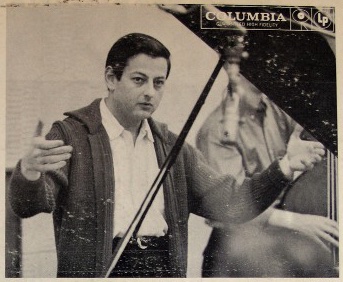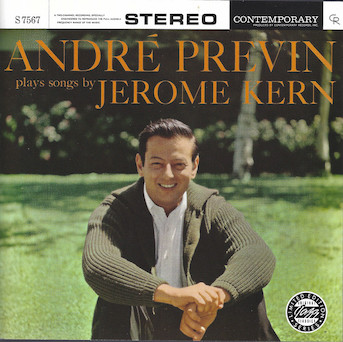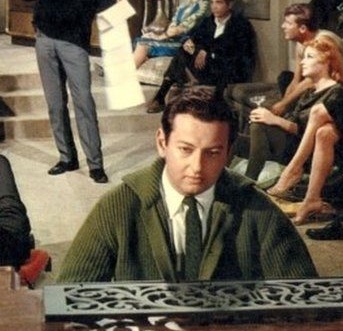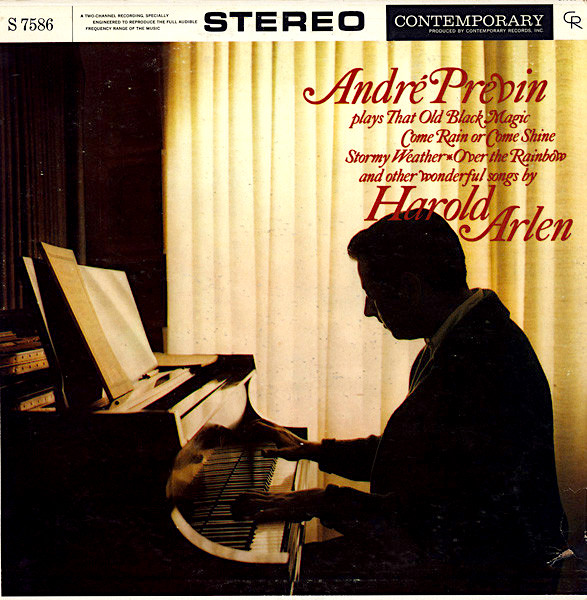Ambience and aspiration.
Like Love (Columbia, 1960) (recorded early 1960?)
Previn’s pop debut for Columbia (“his piano and orchestra,” as the credit reads, for the first time) shows that he learned some lessons from the albums with David Rose. The string arrangements are rhythmically simpler than Rose’s, instead either slipping in with special effects or hanging in the background with Nelson Riddle-style chorales. That lets the piano provide most of the rhythmic interest, just unpredictable enough—so the theory seems to go—to keep the strings from putting too much Vaseline on the lens.
The title track is by far the most swinging thing: a very close cousin to “Like Young,” to be sure (and heavily promoted by Columbia as a single), but with a kind of winsome swagger, if that makes any sense. The other Previn-Langdon number, “Looking for Love,” as well as “Nothing to Do with Love,” a collaboration between Langdon and Russ Freeman, are the most unadulterated easy listening on the record. The rest hovers somewhere in between, but mostly erring on the side of of smooth and unruffled. An exception is a thesis-antithesis “I Wish I Were in Love Again,” the silk-stocking strings in a tug-of-war with Previn’s dry, jumpy piano.
Incidentally, the photo on the back cover of Like Love reveals Previn as a man… who has a favorite sweater.



(That last photo is a still from The Subterraneans.)
André Previn and His Trio: Like Previn! (Contemporary, 1960) (recorded February, March 1960)
Previn’s last trio record for Contemporary is also, surprisingly, his first jazz album consisting only of original tunes. Better late than never. It’s almost as if, when playing standards, Previn’s approach is to show what he can do with them, and the transformations and virtuosity become part of the point; but, with his own music, he’s already shown what he can do, and the improvised explorations are more relaxed (and adventurous). It’s not so much that the music is that much more interesting (though many numbers, especially those on the slower side, are more than deserving of revival), it’s that Previn performs them with a sense of space and collaboration that’s sometimes missing from his other albums. One question is: where might it have come from?
The album that had replaced My Fair Lady as the one best-selling jazz album that everybody seemed to have was But Not For Me: Ahmad Jamal at the Pershing, recorded in January of 1958. It was Jamal’s breakthrough: even two years later, when Like Previn! was released, it briefly shared a space in Billboard’stop ten jazz albums with no fewer than three of Jamal’s, with But Not For Me at the fore. Jamal’s popularity had tripped the same critical suspicion that was beginning to surround Previn; Martin Williams, in Downbeat, called But Not For Me “cocktail piano.” The censure at least was etymologically correct: the album was a distillation of Jamal’s years of experimentation with openness and repetition. Jamal’s sense of space and arrangement was, in comparison with many of his contemporaries, extreme, even avant-garde, but cosseted in the attentive devotion to standards and their construction that Previn extolled. Jamal also preached the gospel of the riff, to which Previn was already an adherent.
But I suspect that those aspects of Jamal’s playing that made their way into Previn’s came through the intermediary of Red Garland, who had absorbed them from Miles, who revered Jamal. (Garland’s stylization and summation of Jamal’s approach, with its solid grounding in the nuts and bolts of popular song, could have been explicitly designed to appeal to Previn.) I also wouldn’t be surprised if Previn had been listening to more by-way-of-Miles spatial experimentation via Bill Evans’ then-new trio with Scott LaFaro and Paul Motian. Previn and Evans were always very similar players—absolute masters of touch and dynamics and voicing—with rather different aims. But the give and take among the trio here, Mitchell a legitimate co-star in melodic and harmonic exposition, Capp more assertive and frisky than he’s been with Previn in the past, bears some passing resemblance to the dynamic in the Evans-LaFaro-Motian outfit.
Previn’s novel idea is to amplify that dynamic by making his usual proofs into postulates: the chord substitutions and stylistic remodeling that are often the goal of Previn’s playing are built into the tunes from the get-go, clearing the way for new improvisatory paths. Previn’s up-tempo originals overlay variations on blues progressions—chromaticism and polytonality on “Tricycle,” unexpected phrase lengths on “I’m Mina Mood” and “Three’s Company,” the latter dividing the material among the three players into a vaguely Brahmsian hemiola. Again, it’s indicative of Previn’s lifelong, outside-looking-in relationship with the blues that he feels most comfortable with that tradition when he’s regarding it from a somewhat self-consciously idiosyncratic vantage. But, taken on their own terms, the tracks provide opportunities for some welcome soloing surprises.
It’s the ballads that are the real finds. I’m more than a little surprised that “Sad Eyes,” for example, has yet to find a second life.
As with King Size!, Like Previn! at times seems to point down a road that, for whatever reason, Previn might have traveled but didn’t.
André Previn and His Trio Play Songs from Lerner & Loewe’s Camelot (Columbia, 1960) (recorded spring 1960?)
If you believe the liner notes, Previn’s first Broadway-show album for Columbia was recorded in four hours. I kind of believe it. It’s an anthology of Previn’s arranging tricks surrounding some straight-ahead soloing, backed by Mitchell and Capp. The etude-like approach of Previn’s solo albums turns up right from the beginning, with an almost bureaucratically polyrhythmic ostinato thumping through “I Wonder What the King Is Doing Tonight” before the trio settles into some up-tempo blowing. It’s far from the only place you can hear echoes of other Previn tracks—“What Do the Simple Folks Do” sounds a bit like his solo version of “Long Ago and Far Away,” “The Lusty Month of May” is reminiscent of “À Toujours” from the Gigi album, and so forth. At times, one can feel the whole single-show-jazz-album format playing itself out in real time, but the good bits are still very good. “If Ever I Would Leave You” is the ballad highlight, with Previn’s playing showing an unexpectedly tart sense of harmony and touch. And the closer, a long, easygoing workout on “The Simple Joys of Maidenhood” (rather in the vein of “Show Me” from the My Fair Lady album) is a real showcase for Previn and Mitchell, with both in a rascally, resourceful mood that plays as a more razzle-dazzle version of Like Previn’s sportif vibe.
André Previn Plays Songs by Harold Arlen (Contemporary, 1961) (recorded May 1960)
For his last solo album on Contemporary, Previn turned to a songwriter with whom he was especially temperamentally aligned. Like Arlen, Previn prized conscientious, elegant craft; like Arlen, Previn was inspired by and attentive to literate and clever lyrics; like Arlen, Previn was earnest and well-versed in jazz, but often approached it (the blues, in particular) from a somewhat aristocratic, intellectual vantage. Maybe that’s why the transformations of the songs here are so thoroughgoing and confident—Previn has absolutely no qualms about getting inside the melodies and harmonies and voiding the warranty, as it were. “That Old Black Magic” is kaleidoscopically polytonal, jumping from key to key and idea to idea in an almost quantum-physical way. “Come Rain or Come Shine” gets fitted around a riff that formalizes the blues to the point that the distance between a flatted third and its natural counterpart feels enormous. In “Over the Rainbow,” Previn seems to be experimenting with just how little of the melody he can play while still convincing your ear that it’s there. For “Stormy Weather,” he inverts the major-minor implications of the blues scale into some breathtaking dissonances.
That almost all this happens at a mellow tempo (only “Black Magic” and “My Shining Hour” take a more sprightly pace) somehow makes it sound more audacious. There’s also very little in the way of conventional improvisation; Previn instead creates the impression of re-inventing progressions and structure as he goes. I could see where one’s reaction to this album might hinge on one’s tolerance for relentless cleverness. Me? I think it’s one of the best things he ever did.
(Also: is that… the sweater?

I think that’s the sweater.)
André Previn and His Trio: Give My Regards to Broadway (Columbia, 1960) (recorded May 1960)
On their second outing for Columbia, the Previn-Mitchell-Capp trio turns away from the single-show format to a miscellany of show tunes, most of a then-recent vintage. It comes off as more conventional than the other Broadway albums; Previn can pick the material to fit the desired mood, eliminating the strain but also the surprise of shoehorning a possibly resistant song into a modern-jazz conception. (The only real revelation is how plausible—and unrecognizable—“Everything’s Coming Up Roses” is as a mid-tempo ballad.) And, if on Like Previn! it felt like the trio was finally coming into its inheritance, here they’re cashing in some of the interest—the pleasure is not hearing the group figure out what they can do, but hearing them do what they’ve figured out they can.
Some of the space and clarified ensemble sound remain from Like Previn!, and Previn’s penchant for playing around with key clashes and transpositions turns up, if not as the dominant flavor, at least as seasoning. The songs come off as underlined rather than transfigured versions of the originals. But the trio has meshed into a tight unit. It’s rather like being in a club and hearing some music in the background, but it’s only when you make yourself stop and listen closely that you realize how well the musicians play together. On “Too Close for Comfort,” Previn isn’t doing anything he hasn’t done many, many times before, but it lands with enough satisfaction that you can see why he keeps doing it.
In his largely complimentary liner notes, Leonard Feather nonetheless feels the need to advocate against pigeonholing Previn—by listing the pigeonholes: “Is this a jazz album, or a pop album, or a show tune album? One could as well argue whether it is an album or an ‘Lp.’” (With friends like these, &c.)
Helen Humes: Songs I Like to Sing! (Contemporary, 1961) (recorded September 1960)
Humes’ second album for Contemporary is as enjoyable as her first even though it’s musically more iffy. Marty Paich is the arranger and conductor this time out, alternating between a small big band and a rhythm-plus-string-quartet-plus-Ben-Webster configuration. Paich does his best to complement Humes, framing as much as accompanying, and the ballads are invariably lovely, but as the tempo increases, so does the shakiness: Humes likes to sing noticeably behind the beat while the players stay firmly on top of it. (A zippy version of “St. Louis Blues” feels constantly on the verge of flying apart.) But this is one of those albums where it sure seems like everyone was having a good time, which counts for a lot. Again, Previn is mostly just part of the band here, but, reunited with Vinnegar and Manne (along with Barney Kessel), he’s in sharp form.
And, let’s be honest, if you can uncork a blues riff with enough wit to make Helen Humes laugh (ca. 1:10), that’s a pretty good day at the office.
This was Previn’s last recording for Contemporary, after signing an exclusive contract with Columbia in the spring of 1960. His run began navigating Lyle “Spud” Murphy’s 12-tone experiments and ended playing well-worn standards with strings for Helen Humes. As tempting as it is to read something into that, I think I’ll just chalk it up to coincidence.
Thinking of You (Columbia, 1961) (recorded November 1960)
“His piano and orchestra” return for an epistolatory collection of songs: “When Will I Hear From You,” “P.S. I Love You,” “Yours Sincerely,” and so on. But compared with Like Love, Previn is determined to push the jazz envelope: take away the strings—and add Mitchell and Capp, or Manne—and this could almost be another trio album. (The bassist and drummer on this recording are uncredited.)
The gold standard for this sort of thing, of course, was and is Charlie Parker with Strings. But, really, Previn’s model is not Parker, but another favorite: Oscar Peterson’s In a Romantic Mood, recorded in 1955, with a string-forward orchestra arranged and conducted by Russ Garcia.
It’s worthwhile to note how Previn and Peterson’s records do and don’t echo Parker’s exemplar. The string sound is similar—the harmonies are a little more au courant, but the textures are in line. But both pianists are more likely to keep the strings offstage while they solo, letting their left hands do what Jimmy Carroll and Joe Lipman’s arrangements did for Parker. And, in Peterson and Previn’s albums, the string section is not there to swing: here and on Like Love, Previn keeps the rhythm to himself and the rest of the trio. (On “P.S. I Love You,” Previn plays swinging phrases, then the strings play straight, emphasizing the contrast.) Another crucial difference that also parallels Peterson’s album: Parker maintained his usual harmonic language, slipping chromaticism and implied passing harmonies into the cracks of the arrangements, but, while Previn’s touch and phrasing are often undiluted hard-bop, he once again sands down his harmonies to match the orchestra.
By the end of the 60s, Previn’s efforts in the easy-listening vein will more closely align with other examples on the racks, particularly as he cedes the arranging duties to others. But on Thinking of You (along with A Touch of Elegance, below), Previn is still thinking in terms of translating his jazz playing to an orchestral setting, as opposed to impersonating the pop-piano-and-orchestra style.
The one Previn original, the moody, modal-bluesy “Lost Letter,” would not have been out of place on Like Previn!, and even the one bit of pop sacrilege, a tango version of “Do Nothing Till You Hear from Me,” is broken up with some solid solos.
Various artists: Who’s Who in the Swinging Sixties (Columbia, 1962) (recorded November 1960)
For this compilation of various Columbia jazz stars—Brubeck, Ellington, Louis Armstrong, Miles—Previn contributed a solo version of Errol Garner’s indelible “Misty,” reworked in a style familiar from Previn’s solo piano albums, but notable for a few passing angularities that are, maybe, the closest thing to a Thelonious Monk influence that ever turned up in a Previn performance. Previn, as we shall see, would say that he admired Monk’s compositions far more than Monk’s playing, but perhaps an iota of the sound came in secondhand.
